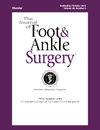美国东南部择期足踝手术患者的社会经济剥夺和术前表现
IF 1.3
4区 医学
Q2 Medicine
引用次数: 0
摘要
在了解社会剥夺如何在实践环境中变化方面仍然存在差距,特别是当它与矫形足部和踝关节手术人群相关时。地区剥夺指数(ADI)是一种工具,可用于比较可能最终影响一个人整体生活质量的社区一级各种健康社会决定因素。在这项调查中,进行了一项回顾性观察性研究,以确定提出选择性足部和踝关节手术干预的患者。基线身体功能通过三个患者报告的结果测量的前瞻性管理进行评估。最终,共有372例患者符合纳入标准进行分析。根据患者的状态ADI十分位数将患者分组,第一个十分位数代表较少的剥夺,第三个十分位数代表更大的剥夺。两组足功能指数得分中位数差异有统计学意义(H = 17.318本文章由计算机程序翻译,如有差异,请以英文原文为准。
Socioeconomic deprivation and preoperative presentation in elective foot and ankle surgical patients in the southeastern US
There are gaps remaining in understanding how social deprivation varies across practice settings, particularly as it relates to orthopaedic foot and ankle surgical populations. The Area Deprivation Index (ADI) is a tool that allows for the comparison of various social determinants of health at the neighborhood level that may ultimately impact a person’s overall quality of life. In this investigation, a retrospective observational study was performed to identify patients presenting for elective foot and ankle surgical intervention. Baseline physical function was assessed through the prospective administration of three patient-reported outcome measures. Ultimately, a total of 372 patients met the inclusion criteria for analysis. Patients were grouped into tertiles according to their state ADI deciles, with the first tertile representing less deprivation and the third representing greater deprivation. The median Foot Functional Index score was statistically significantly different (H = 17.318, P < 0.001). Post-hoc comparisons indicated significant differences between the first and second tertiles (P < 0.001) and the first and third tertiles (P < 0.001). There were no significant associations between ADI tertile and duration of reported symptoms (p = 0.463). Median patient-reported pain was significantly greater among the second and third tertiles relative to the median reported scores in the first tertile. Among a population in the southeastern United States, patients presenting for elective foot and ankle surgery from areas of greater social deprivation were observed to report increased pain and relatively lower physical function compared to those from areas of less deprivation.
求助全文
通过发布文献求助,成功后即可免费获取论文全文。
去求助
来源期刊

Journal of Foot & Ankle Surgery
ORTHOPEDICS-SURGERY
CiteScore
2.30
自引率
7.70%
发文量
234
审稿时长
29.8 weeks
期刊介绍:
The Journal of Foot & Ankle Surgery is the leading source for original, clinically-focused articles on the surgical and medical management of the foot and ankle. Each bi-monthly, peer-reviewed issue addresses relevant topics to the profession, such as: adult reconstruction of the forefoot; adult reconstruction of the hindfoot and ankle; diabetes; medicine/rheumatology; pediatrics; research; sports medicine; trauma; and tumors.
 求助内容:
求助内容: 应助结果提醒方式:
应助结果提醒方式:


